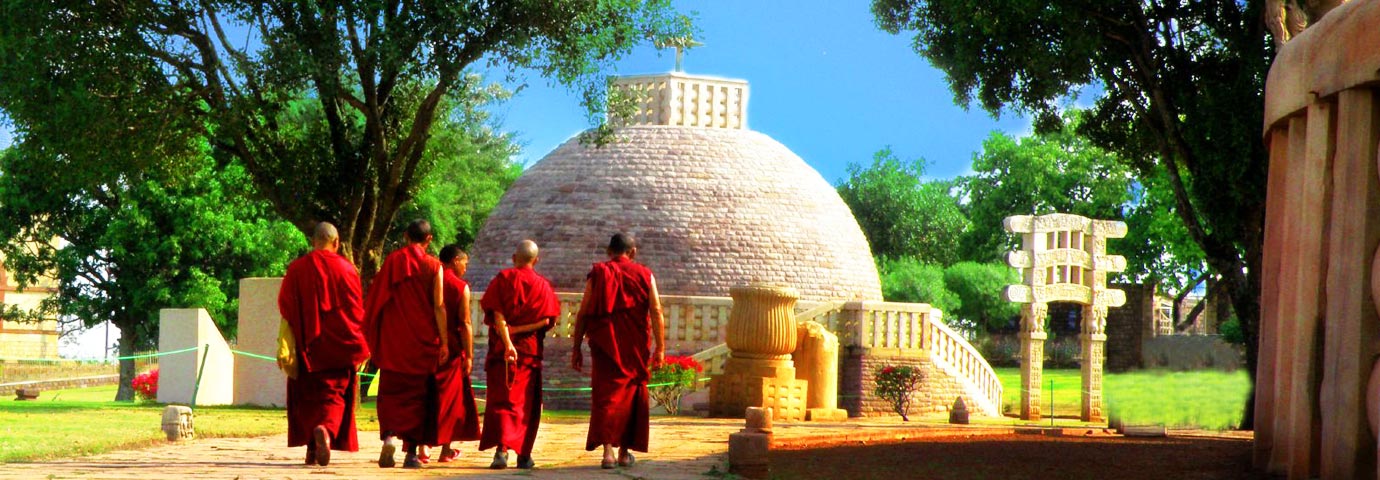Best Time To Visit
You may plan your visit to Sanchi anytime between the months of October and March. In the month of November Sanchi celebrates the festival of Chethiyagiri Vihara. As a part of the rituals of the festival two relics of Gautam Buddha's early disciples are displayed. Accommodation is easily available at Sanchi. The Madhya Pradesh Tourism provides traveler's lodge and tourist cafeteria. Then there are rest houses and other budget accommodations available at Sanchi, which offer all the facilities for a comfort stay. There are several day shelters and cafeterias to cater to the needs of all the tourists who visit Sanchi for a daylong tour.
Tourists Attractions
Owing to their archaeological and historical importance UNESCO has designated the stupas of Sanchi in Madhya Pradesh as the world heritage site. The Buddhist sites at Sanchi were added to the World Heritage List in 1989.
Owing to the association with Buddhism Sanchi has a place of its own in the Cultural as well as Pilgrim tourist map of Madhya Pradesh. Even the historians and the researchers get attracted to Sanchi that has been an ancient seat of Buddhist learning. It has become a shrine for the followers of Buddhism owing to the several structures and sculptures that illustrate the Buddhist legends.
At the site the Archeological Survey of India has a museum. By paying a nominal entry fee you may visit the museum anytime between 9 am and 5 pm. In the museum you may check out the rare and antique exhibits. There is the lion capital of the Ashoka Pillar, several metal objects that were used by the monks besides the earliest known ancient stone sculptures in Indian art from the 3rd to the 1st century BC. The Ashoka Pillar boasts of amazing architectural design and structural balance.
Amongst the many Stupas the most renowned is the Great Stupa I that was built by the Great Mauryan emperor Ashoka. Ashoka built a total of eight stupas at Sanchi in the 3 B.C. though today only three of the Stupas remain. These Stupas have the relics of Buddha like His teeth, hair and the shoulder bones. The Great Stupa 1 is a major tourist attraction at Sanchi. The great Stupa is also referred to as the Ashoka's Stupa who built it in 3 B.C. The original construction of the Stupa was done in burnt mud bricks though later the Stupa was largely re-built in the middle of the 2 B.C. There was a carved railing added with a stone façade to the 16 meter high Stupa. The restructured larger Stupa is what attracts people from across the globe today to Sanchi.
The stone railing that surrounds the base of the Stupa has four gateways. The carving done on the gateways or the Toranas is excellent and captivating. These gateways are examples of best work of art at Sanchi and feature as the finest examples of Buddhist art in India. Three horizontal beams surmount each of these gateways. The carvings illustrate the life and times of Gautam Buddha and his previous incarnations i.e. the Jataka Bodhisattvas and the Manushi Buddhas.
It is noteworthy that at Sanchi there are no figures of Buddha but His representation through symbols. This is in keeping with the tradition of the early period of Buddhism. The lotus is the symbol of the birth of Lord Buddha, the tree of His enlightenment. The wheel symbolizes His first sermon, the Stupa is signifies His Nirvana or Salvation and the footprints along with the throne imply His very presence.
Places Around Sanchi
At a distance of twelve kilometers from Sanchi is the ancient city of Vidisha. Vidisha was also refereed to as Besnagar since it was located on the confluence of the Betwa and the Bes rivers. It is noteworthy that the wife of Ashoka was from Vidisha. In Videsha you must visit the Heliodoros Pillar of the 5 A. D. is dedicated to Lord Vishnu that marks the conversion of the Greek ambassador of Taxila into Hinduism. Till date the local fishermen worship the pillar as Khamb Baba.
Then there are the Hindu and the Jain caves that run in succession at Udaigiri. The rock cut cave sanctuaries of Udaigiri are world- renowned. Both the places are of much historical interest. The Buddhist monks inhabited these caves cut into the sand stone hills in 2 B.C. The caves carry captivating carvings of Lord Vishnu. You may even visit the remains of the 6th century Gupta temple on the top of the hill. The Gupta temple is amongst the pioneer temples that followed the temple architecture in India.
The trip to Sanchi will surely be enjoyable that will offer you a deeper insight into the rich cultural, architectural and religious heritage of India.
How To Reach
By Air - At a distance of 46 kilometers at Bhopal is the nearest airport of Bhopal that connects Sanchi with the other major cities of India like Delhi, Mumbai, Chennai, Gwalior and Indore.
By Rail - The railway station of Vidisha caters to the tourists who travel by trains. The railhead of Vidisha is at a distance of 10 kilometers from Sanchi.
By Road - The road network links Sanchi with Indore, Sagar, Gwalior, Vidisha, Raisen et al. From Bhopal the capital city of Madhya Pradesh several buses and taxis ply to and from Sanchi.


